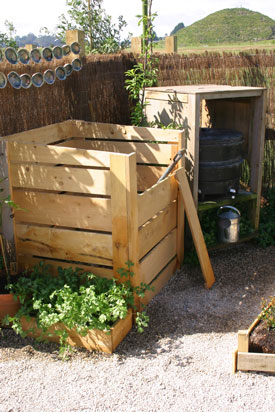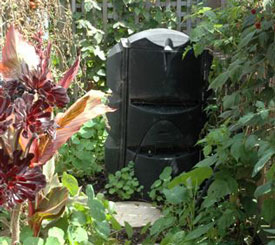Make compost
A good composting system will consume all your garden debris and food scraps, rewarding you with one of nature’s most fundamental allies. Compost feeds your soil, which in turn feeds your plants.
The more diverse the mix of materials used, the more nutritious the compost will be. The most important factor is getting the right balance between brown (dry and carboniferous) and green (wet and nitrogenous) materials. Too much brown matter will result in a dry mix that does not break down. Too much green matter will result in a wet, smelly sludge. The ideal ratio is 10:1, carbon (dry): nitrogen (wet). Carboniferous material soaks up excess moisture from nitrogenous material and nitrogenous material heats up the compost, helping it break down quicker.
Apart from providing nutrient, compost plays an important role in building and maintaining soil structure. Poorly structured soils, such as clay and sand, either drain too quickly or not at all. Regular additions of compost will slowly transform unco-operative soils into a friable loam capable of holding soil moisture, whilst allowing the free passage of air, water and nutrient. Once soils begin to improve, beneficial soil organisms will re-populate the garden, further altering the soil chemistry to create a more balanced composition capable of sustaining a greater range of plants. Composting is an easy, affordable way to improve your garden. All you need is space for a bin – a simple plastic bin for a small garden or a traditional three-compartment wooden bin for a large garden.
Composting Tips
- Don’t add: dairy products, meat, fish, faeces, weed seeds, large bones, oil or fat products, disposable nappies, diseased plant material, hard to kill weeds (e.g wandering Willie, onion weed)
- Do add: green material including: animal manure, grass clippings, green garden prunings, weeds and food waste. Brown material including: paper, wheat, straw, sawdust, wood chips, dry leaves, stalks and branches.
- Use compost activator and turn the heap frequently to quicken the process
- Add dry ingredients (shredded newspaper or egg cartons) if the compost becomes wet and smelly.
- Spread kitchen waste out over entire heap to allow moisture to escape.
Rake and save those leaves
A little bit of leaf litter will rot down and enrich your soil, just as it does in nature. But thick layers of rotting leaves are bad for your lawns and defeat the purpose of paths, patios and driveways. Rake up fallen leaves to keep the lawn healthy. It also pays to remove leaves from groundcovers and succulents (a leaf blower comes in handy here).
Decaying leaves are infinitely more useful in your compost heap. If you don’t have a compost heap, bag your leaves and leave them break down into nutrient-rich organic matter (aka ‘leaf mould’) for the garden. Another way to contain leaves is to make bins out of chicken wire wrapped around a circle of sturdy stakes. Alternatively, shred them with the lawnmower to use as mulch around trees and shrubs.
Compost in 5 easy steps:
1. Lay loose, coarse twigs or small branches on the soil.
2. Add a 15 - 20cm deep layer of green waste.
3. Add a 50cm deep layer of brown waste.
4. Sprinkle over compost activator or blood and bone.
5. Repeat above steps until bin is full and turn frequently to aerate.
Composting techniques and recipes vary widely between gardeners, but a successful compost heap always includes a good balance of green and dry waste and a balance of air and moisture.
1-May-2014





